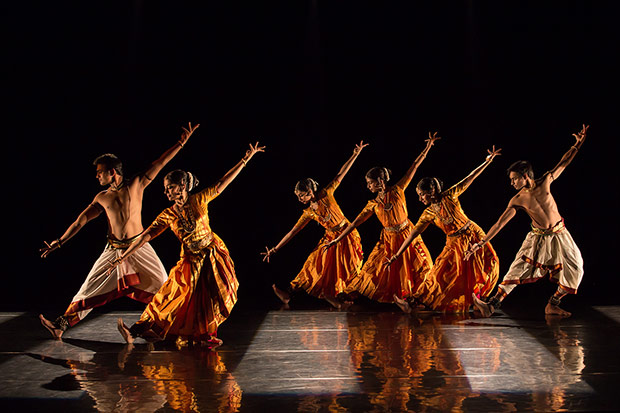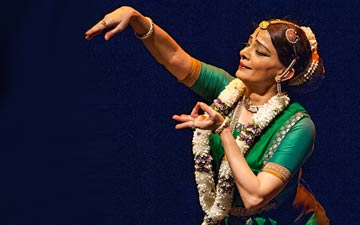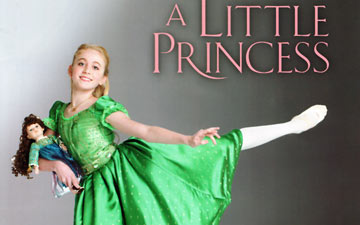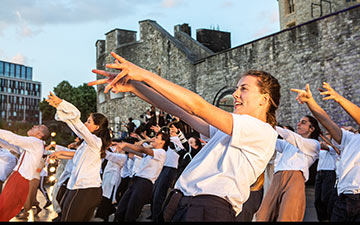
© Shalini Jain. (Click image for larger version)
Malavika Sarukkai
Thari – The Loom
★★★✰✰
London, Queen Elizabeth Hall
24 April 2018
www.facebook.com/malavikasarukkaidance
www.southbankcentre.co.uk
The inspiration for bharatanatyam dancer Malavika Sarukkai to create her group work Thari – The Loom came from the hand weavers of Kanchipuram in India and the elaborately patterned saris that they produce. It’s a colourful, well-structured piece which invokes the sounds and effects of weaving, and is impressively performed by the company. It’s also an ambitious piece integrating dance, music, sound, lighting and poetry in an attempt to evoke the weaving of the sari as a metaphor for the unfurling of a life. However, the voiceover introducing each section began to grate, no so much in respect of the text itself but rather because of the portentous and melodramatic delivery. The dance and the dancers made the better case.
The music for the work is recorded and it became clear why. Not only has Sarukkai and her co-creator Sumantra Ghosal used a large number of musicians and vocalists (ten are credited) but the actual noise of the hand loom itself – the sound of the shuttle flying from side to side, carrying the thread – is embedded into the soundtrack, providing an underlying rhythm. This is most effectively used in the opening section, where the six dancers carry large spindles wound with brightly coloured threads as they move across the stage. At one point they all link arms in a line across the stage as if they themselves were the thread.
The dancers include two men and four women, including the choreographer herself. There is nothing specific to gender in the dance vocabulary. All performers possess wonderfully sinuous and pliant arms and wrists, curving and fluttering. There is great control over every finger position. Credit must go to the lighting designer, GyanDev Singh, who managed to ensure that every critical detail of the body was picked out against a dark background.
All dancers are gorgeously clad in red, with a different scarf or length of fabric around the neck or waist added for each section. Sarukkai does not often deploy them in unison, but groups them, sometimes asymmetrically so that one or more may be at right angles to the rest so we get see movement from different viewpoints.
A devotional aspect is never far away. The text compares the intertwining of the warp and the weft to the love of Radha’s love for Krishna. This gives an opportunity for Sarukkai herself to show the expressional aspects of bharatanatyam as we see ecstatic longing surge through her body and her face.
There are further vignettes as the work explores some of the traditional woven motifs found on the border panels of a sari. Parrots bring love: fluttering hands evoke feathers and flight. The peacock kills a snake, a stylised confrontation between two women. Swans are evoked with white scarves and exquisitely rippling arms. The dancers all have some chance to shine and don’t just function as a backing group for Sarukkai.
The staging is simple but attractive. Five elaborate saris hang as the backcloth, and the stage is otherwise bare. Pathways of light are picked out, sometimes to evoke the borders of the saris. The structure of the work is easy to follow. The voiceover introducing each section is initially helpful, but it becomes histrionic and repetitive, too determined to underline the point. The work lasts for 80 minutes, with what felt like a few false endings towards the close.
It’s good to have the Queen Elizabeth Hall back after its lengthy refurbishment. It provides a much-needed medium size space for dance companies, not as intimidatingly large or as difficult to fill as Sadler’s Wells, but with more space and better sight lines than some of the smaller London venues. It used to have the comfiest seats of any dance venue in London, but the updated ones seem rather firmer than before.
Nevertheless, it’s a great place to see dance up close, and a great venue to appreciate Malavika Sarukkai and her company. Putting so many musical and other collaborators together to make a coherent work is challenging. Even Master Weaver B. Krishnamoorthy gets a credit. There are generous thanks at the curtain calls to many of them and individual bows for the dancers.
Thari – The Loom perhaps doesn’t quite scale the topmost heights of its ambitions, but its aspiration to push at the bounds of the form is laudable and it succeeds in integrating many of its components. The artistry and commitment of the dancers, the noises of the loom and the music are indeed woven together into a satisfying and attractive whole.

















You must be logged in to post a comment.